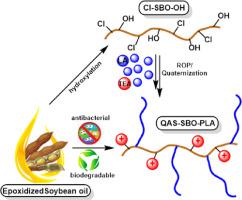Polymer Degradation and Stability ( IF 5.9 ) Pub Date : 2020-08-07 , DOI: 10.1016/j.polymdegradstab.2020.109317 Gokhan Acik

|
The novel hybrid quaternized soybean oil (SBO) and poly (ʟ-lactide) (PLA) based polymer (QAS-SBO-PLA) is synthesized by sequential ring-opening polymerization (ROP) and nucleophilic substitution reaction. In this purpose, oxirane rings of epoxidized soybean oil (ESBO) firstly are modified to chlorine and hydroxyl functionalities by utilizing hydrochloric acid (Cl-SBO-OH). The obtained Cl-SBO-OH is used as macro-initiator for the ROP of ʟ-lactide monomer in the presence of stannous octoate as a catalyst in order to attain the SBO main chain possessing chlorine and PLA pendant groups (Cl-SBO-PLA). Finally, Cl-SBO-PLA is quaternized by triethyl amine to achieve the corresponding material QAS-SBO-PLA. Structural analysis of QAS-SBO-PLA is performed by Fourier transform infrared (FT-IR) and proton nuclear magnetic resonance (1H NMR) spectroscopies, and gel permeation chromatography (GPC) as well, whereas wettability and thermal properties are determined by water contact angle (WCA) measurement, thermogravimetric (TGA) and differential scanning calorimetry (DSC) analyses, respectively. Antimicrobial activity of QAS-SBO-PLA against to gram positive Staphylococcus aureus (S. aureus) and gram negative E. coli (E. coli) bacteria is investigated by agar diffusion method. Moreover, hydrolytic and enzymatic biodegradation behavior of QAS-SBO-PLA is monitored for 30 days in the presence or absence of lipase enzyme. The results of the present study indicate that QAS-SBO-PLA achieved has higher inhibition effect against to S. aureus than E. coli. Furthermore, approximately 44% of QAS-SBO-PLA by weight is degraded in the enzymatic medium, while this degradation percentage found to be 12% for hydrolytic medium in 30 days. It is thus estimated that this facile synthesis method for QAS-SBO-PLA with good antimicrobial and biodegradation abilities will provide beneficial insights to investigators working on biomedical applications.
中文翻译:

季铵盐制备可生物降解的抗微生物杂化大豆油和聚(ʟ-丙交酯)基聚合物
通过顺序开环聚合(ROP)和亲核取代反应合成了新型杂化季铵化大豆油(SBO)和聚(β-丙交酯)(PLA)基聚合物(QAS-SBO-PLA)。为此,首先通过利用盐酸(Cl-SBO-OH)将环氧化大豆油(ESBO)的环氧乙烷环改性为氯和羟基官能团。所获得的Cl-SBO-OH在辛酸亚锡作为催化剂的情况下用作α-丙交酯单体ROP的大分子引发剂,从而获得具有氯和PLA侧基的SBO主链(Cl-SBO-PLA )。最后,用三乙胺将Cl-SBO-PLA季铵化,得到相应的QAS-SBO-PLA材料。QAS-SBO-PLA的结构分析是通过傅立叶变换红外(FT-IR)和质子核磁共振进行的(11 H NMR)和凝胶渗透色谱(GPC),而润湿性和热性能分别通过水接触角(WCA)测量,热重(TGA)和差示扫描量热(DSC)分析来确定。QAS-SBO-PLA的针对于革兰氏阳性抗菌活性的金黄色葡萄球菌(金黄色葡萄球菌)和革兰氏阴性大肠杆菌(大肠杆菌)的细菌是通过琼脂扩散法调查。此外,在存在或不存在脂肪酶的情况下,对QAS-SBO-PLA的水解和酶促生物降解行为进行了30天的监测。本研究的结果表明,QAS-SBO-PLA实现具有抵抗更高的抑制作用金黄色葡萄球菌比大肠杆菌。此外,按重量计约44%的QAS-SBO-PLA在酶促培养基中被降解,而对于水解培养基,该降解百分数在30天内为12%。因此,据估计,这种具有良好的抗微生物和生物降解能力的QAS-SBO-PLA简便合成方法将为从事生物医学应用的研究人员提供有益的见识。


























 京公网安备 11010802027423号
京公网安备 11010802027423号